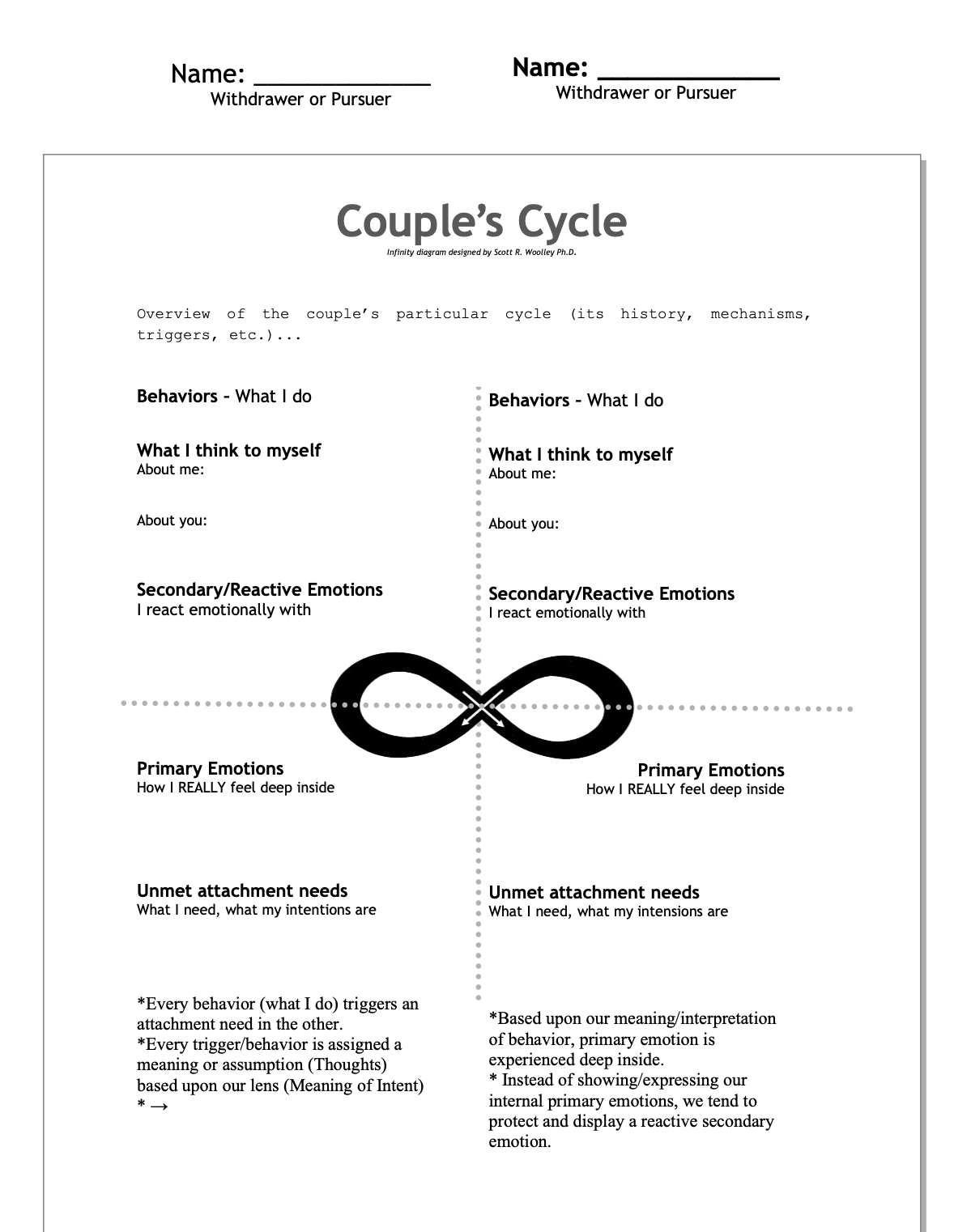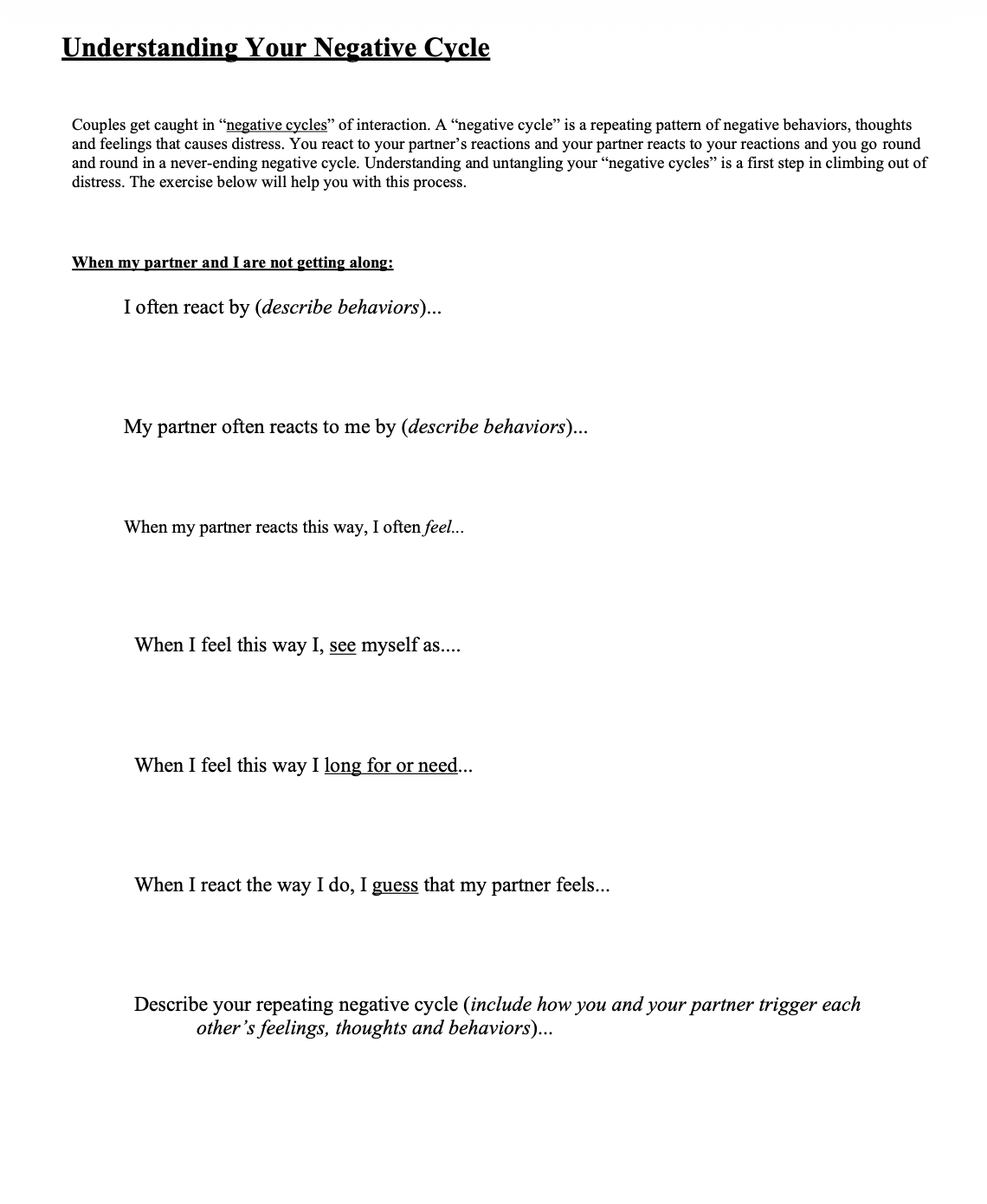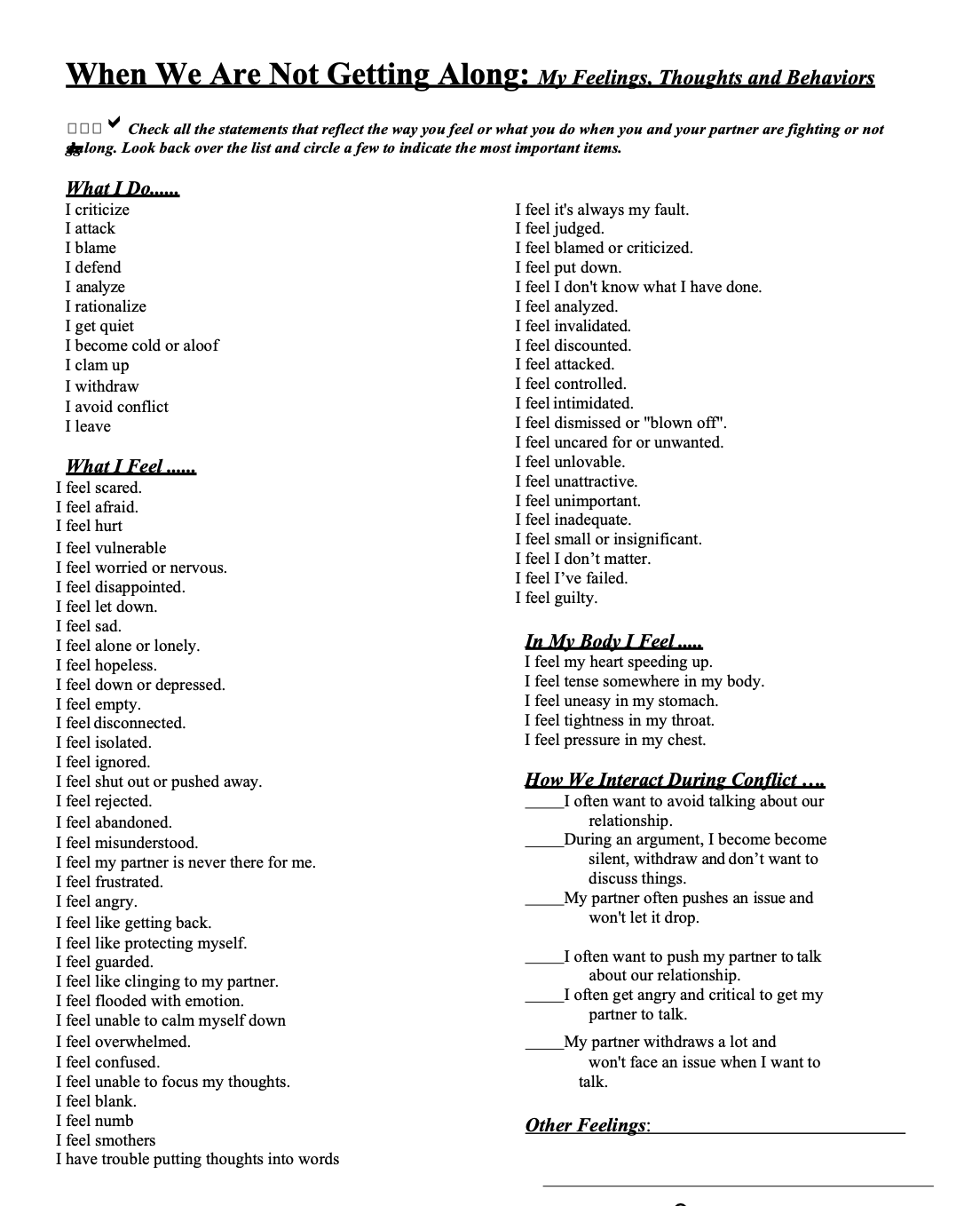
Emotion Focused Therapy for couples is a 3 stage 9 step process that helps couples out of their negative conflict patterns and into secure and safe re-attachment
THE STEPS AND STAGES OF EMOTIONALLY FOCUSED THERAPY FOR COUPLES
EFT FOR COUPLES IS A THREE STAGE NINE STEP PROCESS THAT TAKES A COUPLE OUT OF THEIR NEGATIVE REPETITIVE FIGHTS THAT ARE CAUSING A COUPLE DISTRESS, ANGUISH AND PAIN AND INTO A NEW PLACE OF BONDING AND CONNECTION WHERE THE FIGHTS ARE RESOLVABLE AND SOLUTIONS CAN BE FOUND. IT WAS CREATED BY DR. SUSAN JOHNSON AND BASED ON RESEARCH IN ATTACHMENT THEORY AND EMOTION, AS WELL AS, ON SYSTEMS, HUMANISTIC, AND EXPERIENTIAL TREATMENT MODELS. AS A MODEL ITSELF, IT HAS BEEN VALIDATED BY RESEARCH TO HELP ABOUT 70% OF COUPLES ACHIEVE SOME LONG TERM GAIN.
STAGE ONE - STABILIZATION (ASSESSMENT AND DE-ESCALATION)
In stage one of EFT, the therapist works empathically with the couple helping them identify and break the negative cycle, pattern or what Dr. Johnson calls the dance that keeps them separated and in emotional distress. During this stage of therapy, the therapist helps the couple begin to get more in touch with the underlying feelings, fears, and unmet relationship longings driving the negative dance. Experiencing these emotions and seeing their partner experience them, helps the couple to start to feel close again. Things at home start to go along more smoothly. There is a sense of calm and hope. Finally, in this stage, as de-escalation begins to take root, the individuals in the couple pair begin to see, feel, and understand that together they have created this dance of distress. Each person begins to understand more deeply the effect of his or her behavior on the other. Couple learns to work together as a team to stop the cycle.
Step 1:
Assessment: Delineate conflict issues. Assess how these issues express core conflicts in the areas of separateness/ connectedness and dependence/ independence.
Step 2:
Identify the negative interaction pattern or cycle.
Step 3:
Dive more deeply into and feel and share the emotions underlying and fueling each partners position in the cycle.
Step 4:
Develop an understanding and experience of the problem (reframe) in terms of the cycle, the underlying emotions driving the cycle and the attachment needs which are normal and longing to be meant.
STAGE TWO - BONDING
Once the couple begins to understand the dance they do together and is able to step back and stop it or repair it when it gets going at home, they are ready for stage two of EFT. Stage two essentially involves bonding moments where the couple begins to learn how to communicate their vulnerabilities to each other in a new and non-reactive manner. They are supported by the therapist to take risks in expressing their core sense of self, in asking for the other to be there for them and in requesting understanding and acceptance. Partners take turns reaching out to each other in vulnerability and responding back with empathy creating a new sense of togetherness and secure attachment.
Step 5:
Delve into and identify disowned needs and aspects of self that have been hidden for each partner.
Step 6:
Promote acceptance of these tender and hidden parts, aspects of self and new ways of relating.
Step 7:
Facilitate the expression of needs and wants, and restructure the interaction to create true emotional engagement.
STAGE 3 - CONSOLIDATION OF CHANGE
After the couple has finished the bonding and restructuring events of stage two, they will begin to feel more secure with each other. During stage three, they feel like a team again. The narrative of their relationship has shifted to one where the distress and conflict is understood, resolved, and just part of the story.
Step 8:
Facilitate the emergence of new solutions to old problematic relationship issues.
Step 9:
Consolidate new positions and cycles of emotional closeness and attachment.
Sure, people still fight and sometimes even go back into their cycle. This is normal and will happen especially during times of stress. However, they are able to pull themselves out of it and be there for each other because their sense of self and experience of the relationship has changed. Because of this new ability and sense and during stage three, the focus is more practical and mostly involves consolidating gains and problem solving.
Dr. Sue Johnson provides a brief summary of Emotionally Focused Therapy (EFT). This leading edge, empirically validated form of therapy which is taught all over the world. EFT is based on the last 50 yrs of scientific research on bonding: bonding between mother and child and romantic bonds between partners. EFT provides a map to what matters in intimate relationships: how they work, how they go wrong, and what is needed to put them right.
🌿 EFT Exercises for Couples
Stage 1: Stabilization & De-escalation
1. Catch the Cycle
Together, write down what typically happens when you argue (what each partner does or says).
Give your cycle a name (e.g., “the storm,” “the spiral”) so you can notice it when it starts.
Say out loud: “It’s not you vs. me—it’s us vs. the cycle.”
2. Pause & Breathe
When conflict rises, practice a 3-minute breathing break before continuing.
Hand over heart or hand-in-hand, breathe together and notice your body calming down.
Stage 2: Bonding & Emotional Engagement
3. Share a Vulnerability
Each partner finishes this sentence: “When I get upset, what I really long for is…”
Listen without interrupting. Try to reflect back what you heard: “So when you pull away, what you need is to feel safe with me.”
4. The Hold Me Tight Conversation (inspired by Sue Johnson’s work)
One partner shares a softer, vulnerable feeling (loneliness, fear, or longing).
The other responds with empathy: “That makes sense. I want to be here for you.”
5. Appreciation Ritual
Each night, share one thing you appreciated about your partner that day.
Keep it small and specific (e.g., “Thanks for making me coffee”).
Stage 3: Consolidation & Integration
6. Create a Secure Base Ritual
Develop a ritual that signals support (a goodbye hug, a 6-second kiss, morning check-in).
Use this as a reminder that you are a team, even during stress.
7. Problem-Solving With Needs First
Instead of starting with solutions, each partner says: “My need here is…” (e.g., peace, respect, closeness).
Then brainstorm solutions that honor both needs.
8. Look Back & Celebrate
Together, name 2 ways your relationship feels stronger than before.
Reflect: “How did we get through hard times as a team?”




